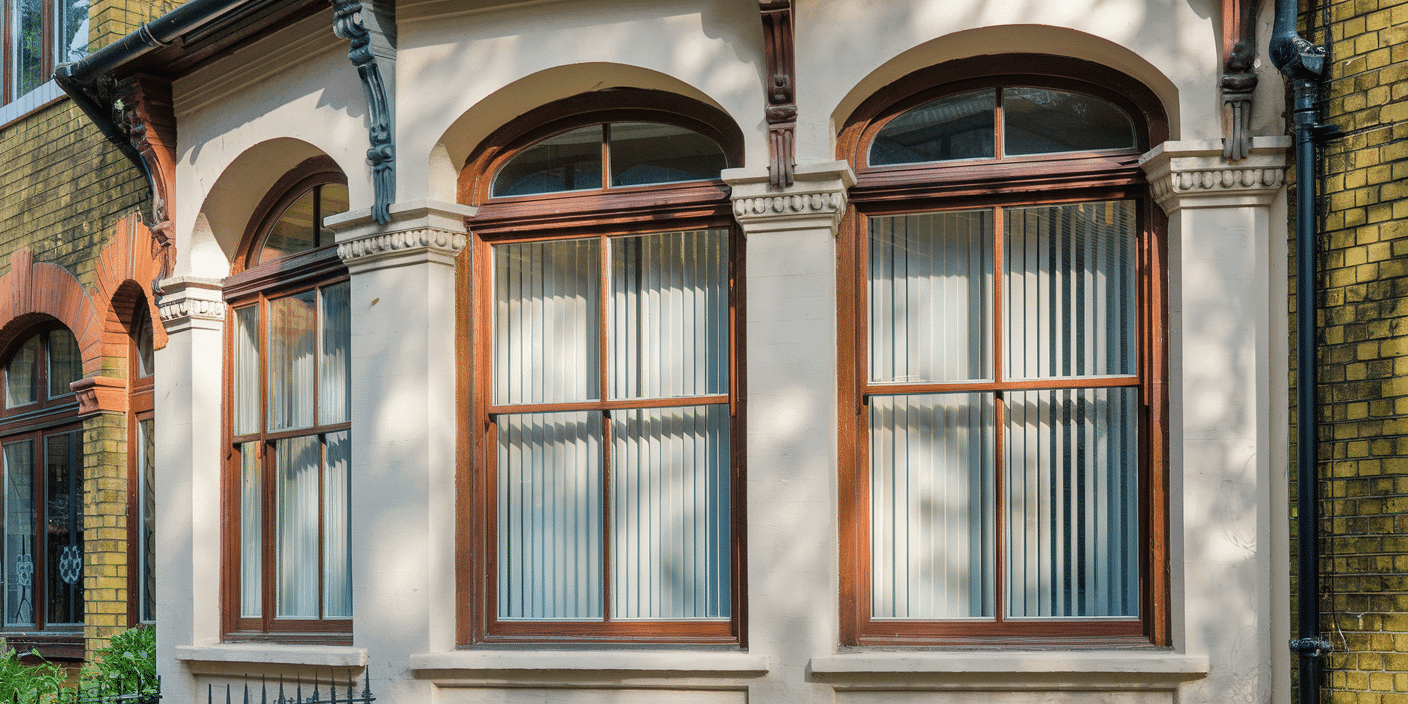The Hidden Heat Leak Undermining Britain’s Finest Homes
Step into any well-maintained London home on a winter morning and the same contradiction appears. The heating is on. The thermostat reads the correct temperature. Yet a thin band of cold hangs at floor level, the corners feel noticeably cooler, and the room never quite settles into comfort.
Most homeowners attribute this to the season, to an ageing boiler, or to the supposed quirks of an older property. Few recognise the real source: the window frames.
Glass is almost never the primary culprit.
It is the frame — the perimeter where heat transfer is most aggressive — that quietly drains warmth from the room. An unbroken aluminium profile functions like a thermal conduit, pulling heat outdoors at a pace no boiler can counter. Ageing timber develops microscopic gaps that behave like narrow chimneys. Even high-quality uPVC can warp just enough under repeated temperature change to allow meaningful heat loss.
Once the frame turns cold, the consequences become obvious.
Condensation gathers along the bottom rail.
A faint draught cuts across the ankles.
The boiler cycles endlessly to maintain what should be an easy equilibrium.
This is the form of heat loss that repeatedly causes homes to underperform on Energy Performance Assessments. Not visible damage. Not failed glass units. Simply frames that were never engineered to prevent conductive heat escape.
Identifying this requires specialist knowledge.
Addressing it requires a company that understands how frames perform under winter conditions — the kind of precise, technical expertise that Sash Windows London brings to every assessment. They recognise what most homeowners can only feel: a well-presented property compromised by a predictable and correctable flaw.
Why Window Frames Fail Energy Assessments (Even With ‘Good’ Glazing)
Most homeowners assume the glass determines the efficiency of a window. It’s a perfectly reasonable guess — after all, the glass is what you see. It’s what sales brochures talk about. It’s what showrooms polish. But an energy assessor doesn’t look at your window the way you do. They look at the numbers, and those numbers reveal a simple, uncomfortable truth:
Your glazing can be excellent — and your window can still fail.
And it fails because of the frame.
A window is a system.
If one part underperforms, the whole unit is downgraded.
This is where the trouble begins.
Older timber frames, with their tiny seasonal gaps, create draught channels that no double glazing can compensate for. Aluminium, without a thermal break, conducts heat as efficiently as a radiator — only backwards, sending warmth out into the cold. Even standard uPVC, which performs well when new, warps just enough over the years to allow air infiltration that quietly destroys thermal performance.
And the assessment process is unforgiving.
The software penalises cold-edge performance heavily.
It recognises the frame as the perimeter where the greatest losses occur.
Even if the centre of the glass performs beautifully, the U-value collapses at the frame junction — the zone most homeowners never think about.
The irony is striking:
You can install brand-new glazing, spend thousands on upgrades, and still fail a modern EPC because your frames are working against you.
This is the blind spot of the industry.
Most installers sell panes of glass.
Very few understand the physics of how heat migrates through the frame — and how that single detail decides success or failure in an energy assessment.
The companies that do understand it, the ones that treat the frame as the critical engineering component, are the ones that consistently help homeowners pass. Sash Windows London belong firmly in that camp. They’ve seen too many homes with premium glazing and substandard frames to make the same mistake twice.
What a Thermal Break Actually Does

Most explanations of thermal breaks drown the reader in jargon. Polyamides. Conductivity coefficients. Bridge interruption. None of it sticks. The truth is simple enough to explain at the kitchen table — and once you understand it, everything else in this article clicks into place.
A thermal break is an insulating barrier built inside the frame of the window.
That’s it.
One small barrier. One decisive interruption.
But the effect is enormous.
Without a thermal break, a window frame behaves like a metal spoon in a mug of tea: heat travels straight through it. The inside warms the outside. The outside cools the inside. Your heating fights a battle it cannot win.
With a thermal break, the spoon is snapped in half and replaced with something that heat cannot easily cross.
The warm side stays warm.
The cold side stays cold.
And the two never meet.
In practice, that means:
- The interior face of the frame no longer drops to near-outdoor temperature.
- Heat no longer drains through the perimeter of the window.
- The internal surface stays warm enough to prevent condensation.
- The U-value of the entire window improves — not just the glass.
You don’t need an engineering degree to understand this.
You simply need to know that frames without thermal breaks bleed heat; frames with thermal breaks hold it.
And this is where the performance gap between ordinary windows and modern systems becomes dramatic. A thermal break doesn’t make a small difference — it changes the rules entirely. A cold aluminium frame becomes a warm, stable component. A once-inefficient sash becomes a high-performance unit. An EPC risk becomes an EPC advantage.
The installers who work with these systems daily — the ones who’ve seen hundreds of homes transformed by a quiet strip of engineered insulation — understand their weight. Sash Windows London has built entire project specifications around thermal breaks because they’ve witnessed, year after year, that nothing else delivers such a reliable leap in performance.
This section gives the homeowner the one insight they were missing:
The frame is no longer the culprit — it becomes the solution.
The System, Not the Component: Why Thermal Breaks Transform U-Values
Most homeowners think of a window as two separate ingredients: the frame and the glass.
Assessment software does not see it that way.
Neither does physics.
A window performs — or fails — as a system.
Every part influences every other part.
And the system is only as strong as its coldest component.
This is where thermal breaks stop being a “feature” and become the structural spine of the entire upgrade.
Start with the most common misconception:
Many people assume that as long as the glass is good — low-E coated, argon-filled, possibly even triple glazed — the window will comply with modern standards. It won’t. If the frame remains cold, the edges of the glass lose heat rapidly, dragging the overall U-value down with them.
A thermal break changes the shape of that entire heat map.
It warms the perimeter zone, which is normally the coldest, weakest point in any window. Once that zone stabilises, everything improves:
- The IGU (insulated glass unit) performs closer to its true spec because its edges are no longer compromised.
- Warm-edge spacers now work at full potential, rather than fighting a losing battle against a cold frame.
- Low-E glass stops radiant heat loss effectively, instead of watching conductive heat drain through the frame.
- The whole-window U-value drops — sometimes by more than half — because the thermal break removes the bottleneck that was undermining everything else.
The frame is the lever that multiplies the value of every other component.
Without a thermal break, the system is unbalanced: premium glass is paired with a substandard frame, and the assessment reflects the weakest performer. With a thermal break, the system behaves as it should — unified, stable, efficient, predictable.
This is why Sash Windows London never talk about glass in isolation.
They design windows as systems.
They specify thermal breaks not because they are fashionable, but because they unlock the performance every homeowner is paying for. They understand how heat moves through a sash, how the perimeter behaves in winter, and why a cold frame can sabotage £5,000 worth of glazing in ten minutes flat.
Once you grasp the system-level logic, the next section becomes inevitable: thermal breaks don’t just improve comfort — they decide whether you pass your energy performance assessment at all.
Passing Energy Performance Assessments: The Truth No One Tells Homeowners
Energy Performance Assessments don’t reward effort, investment, or good intentions.
They reward performance — specifically, measured heat loss.
And the assessment process is far more precise, far less forgiving, and far more frame-focused than most homeowners realise.
When an assessor evaluates your windows, they are not admiring the glazing.
They’re looking at the whole-window U-value: a combined measurement of how your frame, glazing, and installation behave under winter conditions. This number determines your EPC score. And this is where the silent sabotage of cold frames becomes painfully clear.
A good pane of glass might deliver 1.0 W/m²K in the centre.
But if the frame performs at 2.0 W/m²K, the assessor doesn’t use the good number.
They use the compromised one.
The whole window is downgraded to match its weakest performer.
This is why so many homes fail EPC targets even after upgrading their glazing.
The glass was never the bottleneck.
The frame always was.
Thermally broken systems cut through this problem immediately.
They stabilise the perimeter zone — the area assessors scrutinise most heavily.
They eliminate cold bridging.
They prevent the U-value collapse that drags a window from compliant to non-compliant in one calculation.
With a thermal break in place, whole-window U-values fall into the safe, compliant range:
1.4 W/m²K and below — the threshold Part L quietly demands from every replacement and renovation project in the country.
Once the frame barrier is in place, everything else the homeowner invests in — Low-E coatings, warm-edge spacers, gas fills — can finally work at full potential. Instead of fighting a cold perimeter, the system performs as a unified whole. The assessor sees the numbers stabilise, and the EPC rises accordingly.
At this point, compliance is no longer a gamble; it becomes predictable.
And predictability is exactly what Sash Windows London are known for. Their specifications are engineered around the requirements of Part L, not around guesswork. Their installations are designed to produce the same outcome every homeowner wants but rarely receives: a quietly efficient window that passes assessments without argument.
This is the part of the upgrade most companies avoid discussing.
Sash Windows London put it at the centre of their work, because they’ve seen the consequences of getting it wrong: delayed sign-offs, poor EPC scores, draughty rooms, and disappointed homeowners who thought they were buying performance — but only bought glass.
Understanding the assessment logic brings the journey into focus.
In the next section, the conversation turns from compliance to comfort — the lived transformation that proves the numbers were worth chasing.
The Real-World Payoff: Warmer Rooms, Lower Bills, Higher Value

Most homeowners don’t upgrade their windows because they love U-values.
They upgrade because the house feels colder than it should.
Because the boiler never rests.
Because mornings begin with wet sills and cold floors.
Because comfort — real comfort — has quietly slipped away.
Thermally broken windows don’t just fix an energy assessment.
They fix the experience of living in the home.
The first thing homeowners notice is the evenness of the warmth.
Rooms no longer have “hot spots” and “cold corners.”
The temperature stabilises from wall to wall, floor to ceiling.
There is no cold downdraught rolling off the frame. No thin ribbon of chill around the sash. No silent shiver each time someone walks past the window.
Then the heating system stops working so hard.
It clicks on less often.
It holds the temperature longer.
The home finally behaves like a well-sealed structure, not a sieve disguised as a sash.
Over the winter months, the energy bills shift.
They settle.
They level out.
Many homeowners report a quieter kind of relief: they aren’t heating the street anymore. They aren’t fighting the cold. They’re simply warm — naturally warm — in a home that conserves heat rather than leaks it.
One of the most satisfying changes happens on winter mornings:
condensation disappears.
With the interior frame no longer dropping to outdoor temperatures, moisture has nowhere to settle. The days of wiping sills, chasing mould, or dealing with swollen timber come to an end. The home smells fresher, feels healthier, and looks better.
And the gains aren’t only sensory.
A thermally stable property achieves better EPC ratings, which immediately strengthens resale value, mortgage appeal, and desirability — especially in competitive London postcodes where efficiency is becoming a quiet status marker. A warmer home is a more valuable home.
This is the transformation Sash Windows London delivers quietly, confidently, and consistently. Their installations aren’t loud or dramatic. They don’t rely on gimmicks or exaggerated claims. They simply engineer windows that work — windows that hold their warmth, control condensation, pass assessments, and give the homeowner back a feeling they thought they’d lost.
It’s the part of the journey where comfort proves that compliance was worth it.
And it leads naturally to the next question: why some homes demand this upgrade more than others — and why the right installer makes all the difference.
Why High-End Homes Demand Thermally Broken Windows (And Why the Wrong Installer Fails You)
There is a quiet irony in the world of British property.
The homes with the highest ceilings, the finest proportions, the most beautiful sash profiles — the homes that look the warmest — are often the ones that leak heat the fastest. Large bay windows, generous room volumes, exposed elevations and heritage constraints create an environment where a small weakness becomes a large discomfort.
In a typical three-bedroom flat, a cold frame is an annoyance.
In a high-end London townhouse, a cold frame is a systemic failure.
You feel it more. You pay for it more. And it reflects more directly on the value of the property.
This is why premium homes demand thermally broken windows.
Not for luxury.
Not for indulgence.
But because their architecture magnifies any performance flaw.
Consider three realities:
- Larger rooms amplify heat loss.
A draught that feels minor in a modest room becomes a five-degree cold patch in a drawing room with a three-metre ceiling. - Heritage windows have more perimeter edge — the weakest thermal zone.
More perimeter means more opportunity for heat to escape.
A frame without a thermal break simply cannot hold temperature in a period façade. - High-end buyers are EPC-conscious.
Estate agents won’t say it out loud, but EPC ratings quietly influence decisions at the upper end of the market. A drop from Band C to Band D can reshape negotiations instantly.
This is not the environment for “standard” installers who treat every window the same way.
A high-end home is an ecosystem, not a commodity. Its comfort depends on precision in measurement, specification, airtightness, and thermal engineering. Without that precision, the home ends up with beautiful frames that behave like radiators facing backwards.
This is where Sash Windows London’s role becomes unmistakably clear.
They don’t just install windows; they interpret the house.
They understand heritage proportions, conservation constraints, and the engineering challenge of achieving modern performance without damaging period character. They know how to specify thermal breaks that complement sash profiles rather than distort them. And, crucially, they install with the accuracy required for airtightness — the detail that separates a perfect upgrade from a cold disappointment.
The difference between a compliant, comfortable, energy-stable home and a costly misstep is not the window alone.
It’s the specialist who knows how to integrate that window into the fabric of a prestigious property without compromise.
This section answers the final unspoken question:
Why does this matter so much more in a high-end home?
Because every weakness is amplified — and every improvement is transformational.
All that remains now is the next step: turning clarity into action.
The Quiet Fix That Changes Everything — Your Next Step
By now the pattern is unmistakable.
The cold you feel in winter isn’t random.
The uneven warmth isn’t “just an old house thing.”
The disappointing EPC score isn’t a mystery.
It all traces back to one fragile component: a frame that was never engineered to hold its heat.
A thermal break corrects that flaw.
It stabilises the entire window system.
It lifts your EPC rating, cuts your heating demand, sharpens your comfort, and protects the value of a home that deserves far better than seasonal compromise.
And it does all of this quietly — without altering the character of your sash windows, without disrupting the façade, without forcing you into an aesthetic you never asked for.
The only real decision left is who should deliver that upgrade.
Sash Windows London approach performance the way a good tailor approaches fit: with precision, discretion, and a respect for the architecture that goes far beyond the technical paperwork. They design for compliance, install for airtightness, and finish with the kind of care that high-end homes rely on. Their work doesn’t call attention to itself; it simply works. Winter after winter, year after year.
If you want a home that finally holds its warmth,
if you want confidence in your EPC assessment,
and if you want windows that perform as beautifully as they look — the next step is a conversation, not a commitment.
Request a performance consultation.
A quiet, thoughtful review of your home, your frames, and your compliance requirements.
No noise. No pressure. Just clarity.
Because when you fix the frame, you fix the home.
And once you feel the difference, you won’t go back.







